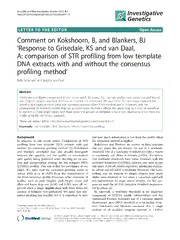
Comment on Kokshoorn, B, and Blankers, BJ 'Response to Grisedale, KS and van Daal, A: comparison of STR profiling from low template DNA extracts with and without the consensus profiling method'. PDF
Preview Comment on Kokshoorn, B, and Blankers, BJ 'Response to Grisedale, KS and van Daal, A: comparison of STR profiling from low template DNA extracts with and without the consensus profiling method'.
GrisedaleandDaalInvestigativeGenetics2013,4:2 http://www.investigativegenetics.com/content/4/1/2 LETTER TO THE EDITOR Open Access Comment on Kokshoorn, B, and Blankers, BJ ‘ Response to Grisedale, KS and van Daal, A: comparison of STR profiling from low template DNA extracts with and without the consensus ’ profiling method Kelly Grisedale* and Angela van Daal Abstract Kokshoorn and Blankers responded to our recent article bysayingthat replicate analysis and consensus profiling of low template samples was best in terms ofreliability and objectivity.We agree thattheconsensus approach has benefits, particularly ineliminating non-repeating spurious alleles from thefinal profile. However, with the development of statistical models that can accommodate stochastic effects and allele drop in, it may be beneficial to perform a single amplificationwith three times the amount of template, since much informationis lost from the profile using the consensus approach. Please see related article:http://www.investigativegenetics.com/content/4/1/1 Keywords: LowtemplateDNA, Stochastic effects, Consensus profiling Background just how much information is lost from the profile when In response to our recent article ‘Comparison of STR the consensusmethodisapplied. profiling from low template DNA extracts with and Kokshoorn and Blankers are correct in their response without the consensus profiling method’ [1], Kokshoorn that our paper did not discuss the use of a stochastic and Blankers concluded that ‘one should distinguish threshold. Use of a stochastic threshold provides a means between the quantity and the quality of information’, to confidently call alleles in mixture profiles. We believe with quality being preferred when deciding on an ana- that stochastic thresholds have value. However, with the lysis and interpretation strategy for low template DNA increased sensitivity of LTDNA analyses, one mustaccept (LTDNA) profiles. Thiswas in fact the conclusion of our thatmost,ifnotall,resultsexperiencesubstantialstochas- paper. We agree that the consensus profiling works to ticeffectsandfallbelowastochasticthreshold.Ourwork, reduce allele drop in (ADI) from the interpretation of instead, was an exercise to simply observe how many the final consensus profile. However, other measures of alleles were obtained or lost when a consensus approach quality, such as peak heights, peak height ratios and was implemented for single source samples. For that pur- allele and locus drop out (ADO and LDO) were all im- pose we used the 50 RFU detection threshold implemen- proved when a single amplification with three times the tedbyothers[2]. amount of template was performed. We agree that con- In casework, a stochastic threshold is an important sensus profiling has benefits, but it is important to note component of LTDNA profile interpretation and the Netherland Forensic Institute’s use of a validated relative fluorescence units (RFU) threshold is to be lauded. How- *Correspondence:[email protected] ever, Kokshoorn and Blankers’ statement that ‘a single FacultyofHealthSciencesandMedicine,BondUniversity,GoldCoastQLD analysis of all available template material in LTDNA 4229,Australia ©2013GrisedaleandDaal;licenseeBioMedCentralLtd.ThisisanOpenAccessarticledistributedunderthetermsofthe CreativeCommonsAttributionLicense(http://creativecommons.org/licenses/by/2.0),whichpermitsunrestricteduse, distribution,andreproductioninanymedium,providedtheoriginalworkisproperlycited. GrisedaleandDaalInvestigativeGenetics2013,4:2 Page2of2 http://www.investigativegenetics.com/content/4/1/2 samples,asproposedbyGrisedaleandVanDaal,willgen- interpretations that accommodate the stochastic effects erallynotyieldaDNAprofileofsufficientquality(thatis, andcontamination. with all alleles of all donors above the stochastic thresh- old)’and therefore any results from a single amplification Abbreviations ADI:Alleledropin;ADO:Alleledropout;LDO:Locusdropout;LTDNA:Low are less objective than a consensus profile, seems odd, templateDNA;RFU:Relativefluorescenceunit.STR,Shorttandemrepeats.. since there is no guarantee that a consensus profile will Competinginterests achieve this measure of validity either. Indeed, splitting a Theauthorsdeclarethattheyhavenocompetinginterests. sample reduces the chance that any alleles in each of the aliquots can meet the stochastic threshold. Thus, under Received:4December2012Accepted:4December2012 Published:3January2013 theKokshoornandBlankersapproachmostLTDNAsam- ples would yield little information. In addition, if only References alleles above the threshold are called in a consensus pro- 1. GrisedaleKS,vanDaalA:ComparisonofSTRprofilingfromlowtemplate DNAextractswithandwithouttheconsensusprofilingmethod. file, then this approach can equally be applied to a profile InvestigativeGenet2012,3:14. fromasingleamplification. 2. TuckerVC,HopwoodAJ,SprecherCJ,McLarenRS,RabbachDR, Kokshoorn and Blankers are stating well accepted prin- EnsenbergerMG,ThompsonJM,StortsDR:Developmentalvalidationof thePowerPlexWESI16andPowerPlexWESI17systems:STRmultiplexes ciples in their comments that mixture profiles involve forthenewEuropeanstandard.ForensicSciIntGenet2011,5:436–448. morecomplexinterpretations.Thisistruewhetherornot 3. GillP,CurranJ,NeumannC,KirkhamA,ClaytonT,WhitakerJ,LambertJ: aconsensusapproachisapplied.Allelesfromaminorcon- InterpretationofcomplexDNAprofilesusingempiricalmodelsanda methodtomeasuretheirrobustness.ForensicSciIntGenet2008,2:91–103. tributor shouldalwaysbeinterpretedwithcarebecauseof 4. GillP,WhitakerJ,FlaxmanC,BrownN,BuckletonJ:Aninvestigationofthe the potential for stochastic effects and the possibility of rigorofinterpretationrulesforSTRsderivedfromlessthan100pgof allele-sharing with a major contributor. Their points fur- DNA.ForensicSciInt2000,112:17–40. 5. GillP,KirkhamA,CurranJ:LoComatioN:asoftwaretoolfortheanalysisof ther support our position; allele-sharing and stochastic lowcopynumberDNAprofiles.ForensicSciInt2006,166:128–138. effectsincrease withdecreasing amounts of total template 6. CurranJ,GillP,BillMR:InterpretationofrepeatmeasurementDNA DNAperamplification.However,statisticaltoolsarebeing evidenceallowingformultiplecontributorsandpopulationsubstructure. ForensicSciInt2005,148:47–53. developed that may accommodate these issues and have 7. MitchellAA,TamarizJ,O’ConnellK,DucasseN,BudimlijaZ,PrinzM, beenimplementedinsomelaboratories. CaragineT:ValidationofaDNAmixturestatisticstoolincorporating In 2008, Gill et al. [3] stated, ‘There is currently no allelicdrop-outanddrop-in.ForensicSciIntGenet2012,6:749–761. 8. HanedH:Forensim:Anopen-sourceinitiativefortheevaluationof statistical model that incorporates all these parameters statisticalmethodsinforensicgenetics.ForensicSciIntGenet2011, simultaneously. In this respect, all existing models must 5:265–268. be considered incomplete (indeed we must consider that 9. PerlinMW,LeglerMM,SpencerCE,SmithJL,AllanWP,BelroseJL,DucemanBW: a complete model is unattainable)’. However, the state- 5V6a:l1id4a3t0in–g14T4r7u.eAlleleWDNAMixtureInterpretation.JForensicSci2011, ment following the aforementioned quote was, ‘Howe 10. BaldingDJ,BuckletonJ:InterpretinglowtemplateDNAprofiles. ver, the theory is well established, and the parameters of ForensicSciIntGenet2009,4:1–10. probability of dropout and probability of contamination doi:10.1186/2041-2223-4-2 can be universally applied to all DNA profiles using the Citethisarticleas:GrisedaleandDaal:CommentonKokshoorn,B,and framework originally described by Gill et al. [4], and Blankers,BJ‘ResponsetoGrisedale,KSandvanDaal,A:comparisonof programmed into an expert system [5,6]’. In the four ScoTRnspernosfuilsinpgrofrfoilminglomwettehmodp’l.aItneveDstNigAateivxetrGaecntsetwicisth20a1n3d4w:2i.thoutthe years since this paper by Gill et al. [3] was published, further statistics software programs for the interpre- tation of mixture profiles have been developed which may accommodate ADO and ADI [7-10]. The consensus profiling method was initially developed to overcome the stochastic effects, particularly ADI [4]. If the statis- tical programs can incorporate these stochastic issues Submit your next manuscript to BioMed Central into the model, the evidence would be maximized by and take full advantage of: applying these tools to the DNA profile that contains the most information with the proper uncertainty/confidence • Convenient online submission associated. • Thorough peer review Overall, our conclusions remain the same: the consen- • No space constraints or color figure charges sus approach will certainly be beneficial for dealing with • Immediate publication on acceptance ADI. However, when the template amount is limited, the • Inclusion in PubMed, CAS, Scopus and Google Scholar most informative profile will likely be gained by a single • Research which is freely available for redistribution amplification which can be analyzed using statistical Submit your manuscript at www.biomedcentral.com/submit
